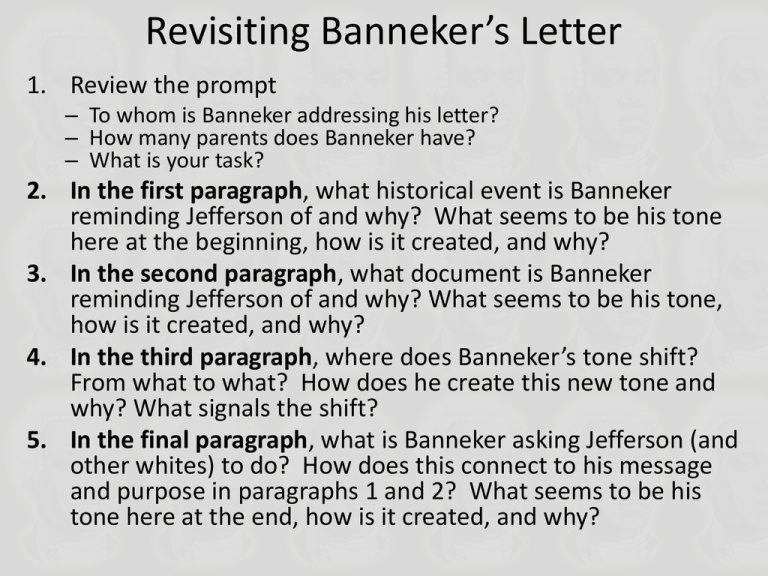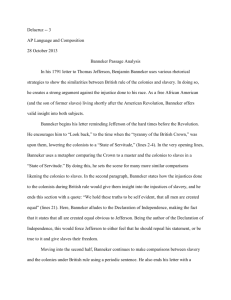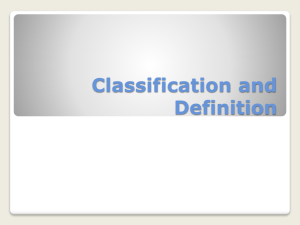Revisiting Banneker*s Letter
advertisement

Revisiting Banneker’s Letter 1. Review the prompt – To whom is Banneker addressing his letter? – How many parents does Banneker have? – What is your task? 2. In the first paragraph, what historical event is Banneker reminding Jefferson of and why? What seems to be his tone here at the beginning, how is it created, and why? 3. In the second paragraph, what document is Banneker reminding Jefferson of and why? What seems to be his tone, how is it created, and why? 4. In the third paragraph, where does Banneker’s tone shift? From what to what? How does he create this new tone and why? What signals the shift? 5. In the final paragraph, what is Banneker asking Jefferson (and other whites) to do? How does this connect to his message and purpose in paragraphs 1 and 2? What seems to be his tone here at the end, how is it created, and why? Revisiting Banneker’s Letter 1. Review the prompt – – – 2. 3. 4. 5. Banneker is addressing Thomas Jefferson only. Banneker is the son “of former slaves” not “of a former slave.” Your task is to analyze how Banneker uses rhetorical strategies…so be sure that you are identifying and explaining the effect of certain strategies and devices. In the first paragraph, Banneker is reminding Jefferson of the American Revolution, specifically of the indignation and betrayal Jefferson and other colonists felt because of British tyranny. Banneker expects Jefferson to realize that slaves are currently feeling that same indignation and betrayal. Jefferson should be able to relate. Through formal language, the repetition of the direct address “sir”, and other deferential diction (“suffer me to” and “I entreat you”), Banneker creates a respectful tone because he’s addressing a pretty important figure in Jefferson, but also because it helps set up his critical tone in the third paragraph. In the second paragraph, Banneker references the Declaration of Independence (which Jefferson wrote) in order to remind Jefferson of his own proclamations concerning universal freedom and rights of humans. This is to set up his implication in the third paragraph that Jefferson, by owning slaves, is contradicting his own philosophy and is, therefore, a hypocrite. Banneker’s tone here is still respectful, even admiring, when he describes the D of I as a “true and valuable doctrine…worthy to be recorded and remembered in all succeeding ages.” In the third paragraph, Banneker switches from a respectful tone to a slightly critical one, signaled by the transition word “but”. The critical tone is mostly revealed through Banneker’s dark and accusatory diction (“how pitiable”, “you should counteract his mercies in detaining by fraud and violence…under groaning captivity and cruel oppression”) but also through the juxtaposition of Jefferson’s words versus his actions, which reveals situational irony, which in turn exposes Jefferson’s hypocrisy. In the final paragraph, Banneker resumes his respectful tone, acknowledging that Jefferson’s “knowledge of the situation is too extensive” for Banneker to need to beat him over the head with it. Banneker simply requests Jefferson (and other slaveholding whites) to empathize with the slaves, which Banneker communicates through a Biblical allusion—“put your souls in their souls stead.” This entreaty to empathize with the slaves echoes Banneker’s intention in the first paragraph and is, arguably, the primary purpose of his letter. Evaluating Sample Essays • Score each essay (1-9) and write a brief explanation for your scoring. • Consider—How well did the student… – – – – – – – – “get” Banneker’s ideas? identify Banneker’s purpose and tone(s)? analyze Banneker’s strategies and devices? select textual evidence (Detail)? weave the quotes into his/her own words (Elaboration)? organize his/her essay? write with accurate, specific, sophisticated diction? vary his/her syntax? Evaluating Sample Essays • • • • Essay V scored a 5. Essay R scored a 7. Essay D scored a 9. Essay TT scored a 4.







